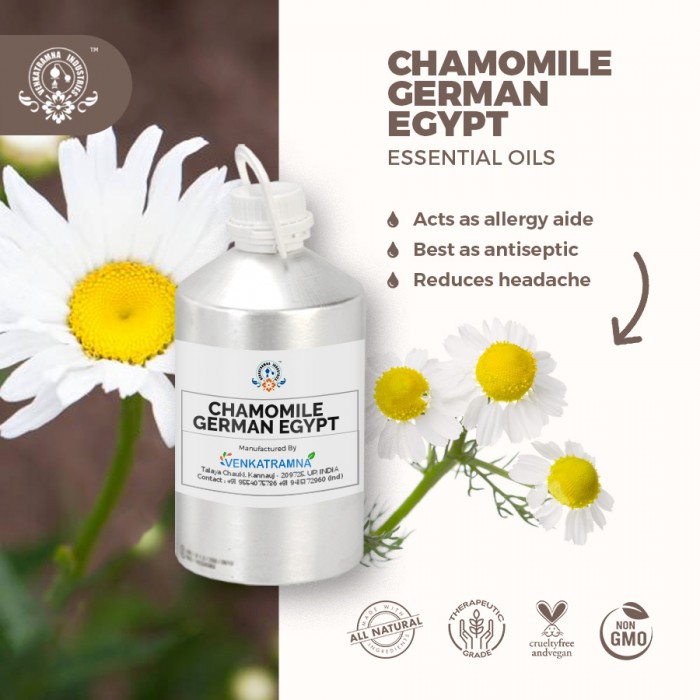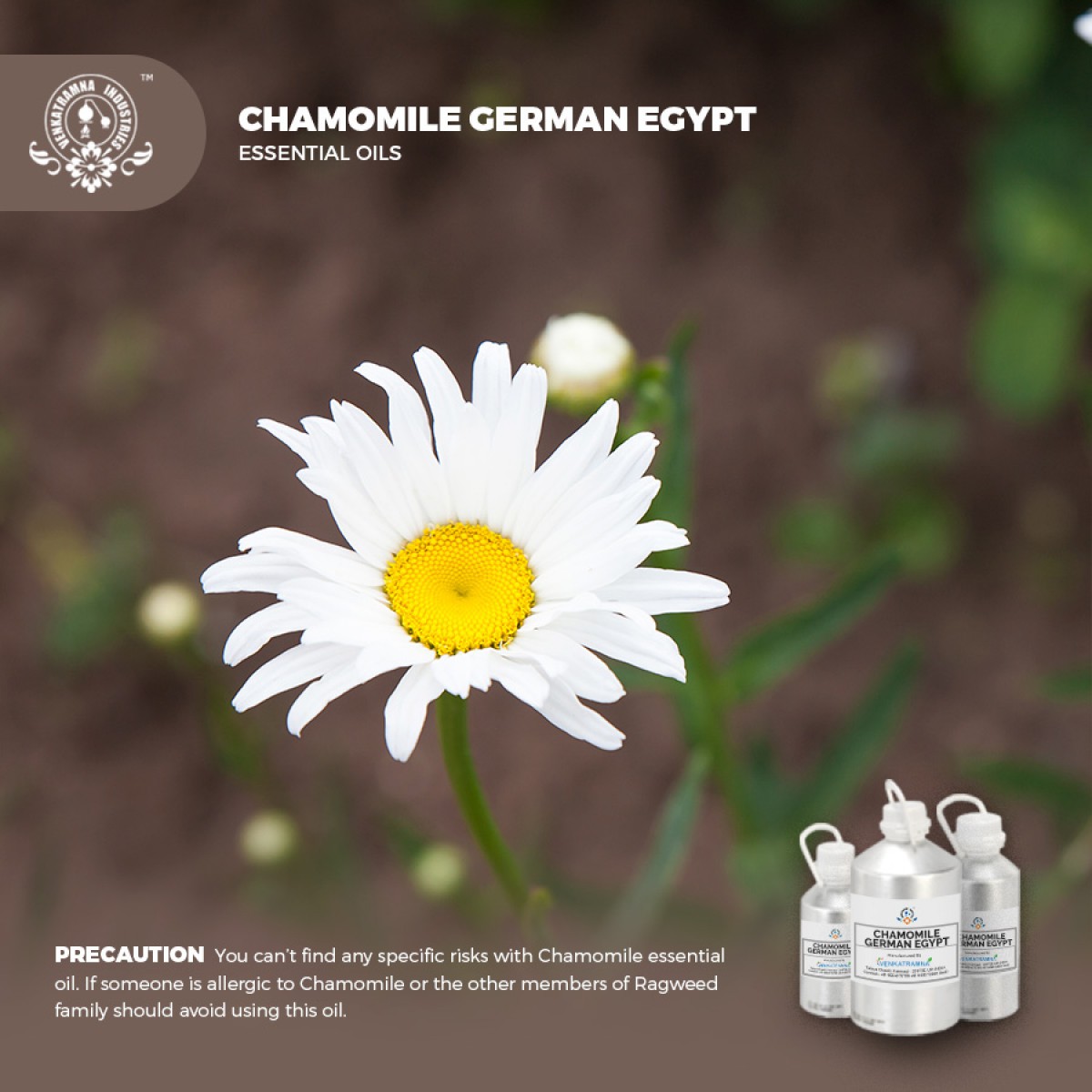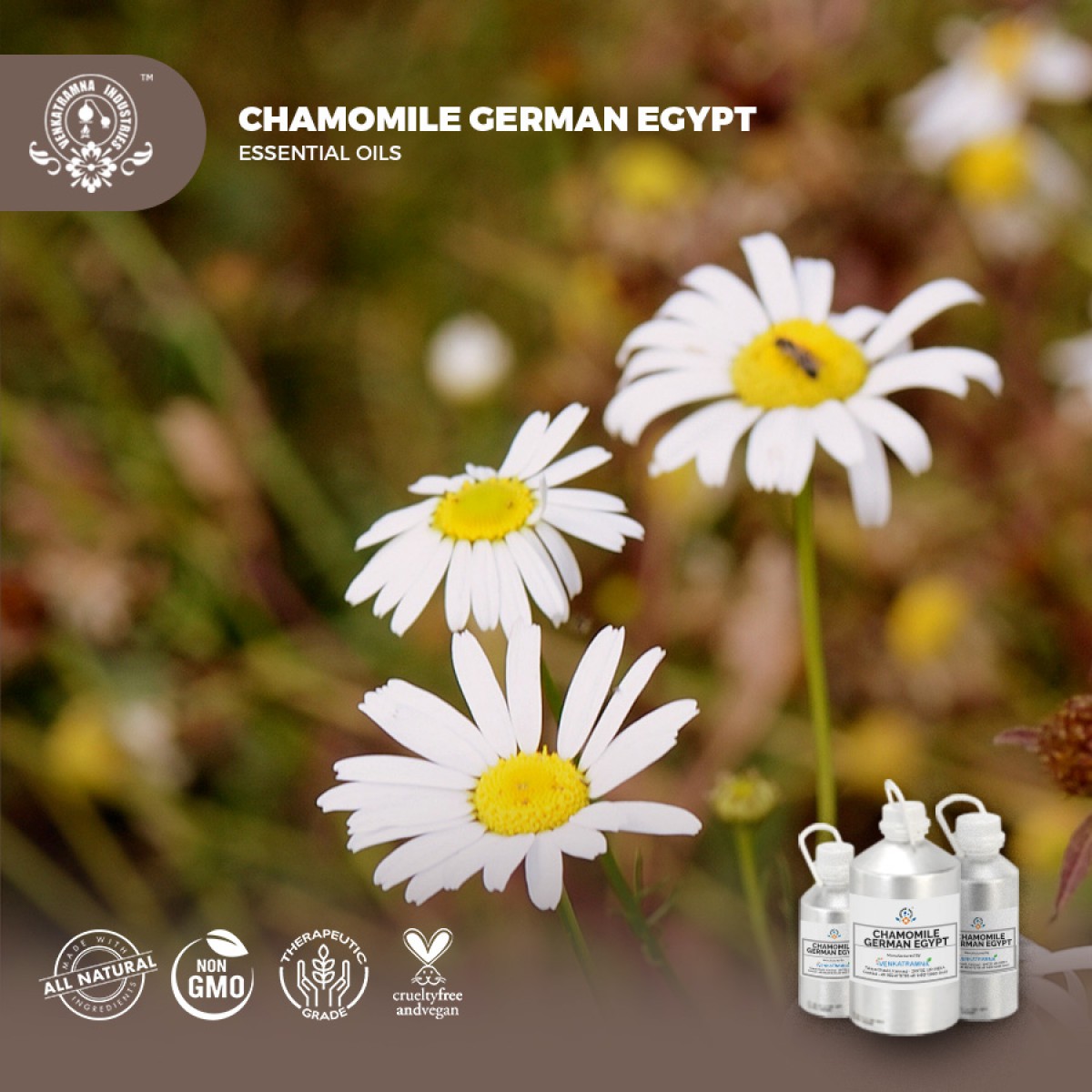Botanical Name: Matricaria chamomila L. Common name: German chamomile, Hungarian ch Read More
|
Botanical
Name: |
Matricaria chamomila L. |
|
Common name: |
German chamomile, Hungarian chamomile, sweet false chamomile |
|
Plant family: |
Asteraceae |
|
Genus: |
Matricaria |
|
Appearance/Color: |
A medium bluish green to deep blue liquid. |
|
Odor: |
The chamomile essential oil spreads sweet scent which smells like
apple straw. |
|
Blends With: |
Lavender, clary sage, bergamot, tea tree, neroli, lemon,
patchouli, geranium, rose, jasmine and ylang-ylang. |
|
Origin |
Egypt, Germany |
Chamomile is a plant that has
been used since ancient Egypt in a variety of healing applications. Chamomile
is a native of the Old World; it is related to the daisy family, having
strongly scented foliage and flowers with white petals and yellow centers. The
name chamomile is derived from two Greek words that mean “ground” and “apple,”
because chamomile leaves smell somewhat like apples, and because the plant
grows close to the ground.
There are two varieties of
chamomile commonly used in herbal preparations for internal use and
for aromatherapy. One is called Roman chamomile (Anthemis
nobilis), with contemporary sources in Belgium and southern England. Roman
chamomile grows to a height of 9 in (23 cm) or less, and is frequently used as
a ground cover along garden paths because of its pleasant apple scent. German
chamomile (Matricaria recutita) is grown extensively in Germany,
Hungary, and parts of the former Soviet Union. German chamomile grows to a
height of about 3 ft (1 m) and is the variety most commonly cultivated in
the United States, where it is used medicinally.
Moroccan chamomile is a member of the tansy botanical family and is like German chamomile since day both produce a deep, ink-blue color when in the form of an essential oil. Out of the two varieties, Moroccan chamomile has the highest levels of chamazulene; however, there are some chamomiles that are not blue in color. They are appelled Moroccan chamomile because they are a variety of chamomile that is a grown in morocco. True Tanacetum annuum is blue and contains the highest levels of chamazulene; however, there is some concern with Tanacetum annuum, also called blue tansy oil.
DISCLAIMER
The complete range of conditions
or methods of use are beyond our control therefore we do not assume any
responsibility and expressly disclaim any liability for any use of this
product. Information contained herein is believed to be true and accurate however,
all statements or suggestions are made without warranty, expressed or implied,
regarding accuracy of the information, the hazards connected with the use of
the material or the results to be obtained from the use thereof. Compliance
with all applicable federal, state, and local laws and local regulations
remains the responsibility of the user.
The FDA has not evaluated the
statements on this website. No claims are made by Venkatramna Industries as to
the medicinal value of any products from vriaroma.com or by us. The information
presented here is for educating our customers about the traditional uses of
essential oils and is not intended to diagnose, treat, cure, or prevent any
disease. You are responsible for understanding the safe application of these products.
If you have any questions, please call or email us for further information.
As per NAHA guidelines, New Directions Aromatics (NDA) does not recommend the ingestion of essential oils. It is imperative to consult a medical practitioner before using Essential Oils for therapeutic purposes. Pregnant and nursing women and those taking prescription drugs are especially advised not to use this product without the medical advice of a physician. The oil should always be stored in an area that is inaccessible to children, especially those under the age of 7.
Chamomile has been used
internally for a wide variety of complaints. The traditional description of
chamomile is alles zutraut, which means that the plant “is good for
everything.”
Chamomile Essential Oil in
Pharma
Chamomile has been used for the
following purposes, in pharmaceutical and ayurvedic industries to treat the
following medical conditions:
Antispasmodic: A
preparation given to relieve intestinal cramping and relax the smooth muscles
of the internal organs. Chamomile is used as an antispasmodic to relieve
digestive disorders, menstrual cramps, premenstrual syndrome (PMS), headache,
and other stress-related disorders.
Anthelminthic: Chamomile
has been used to expel parasitic worms from the digestive tract.
Carminative: Chamomile is
given to help expel gas from the intestines.
Sedative: Perhaps the most
frequent internal use of chamomile is in teas prepared to relieve anxiety and
insomnia.
Anti-inflammatory: Roman
chamomile has been used to soothe the discomfort of gingivitis (inflamed gums),
earache, and arthritis. German chamomile is used in Europe to treat oral
mucosities in cancer patients following chemotherapy treatment.
Antiseptic: Chamomile has
mild antibacterial properties and is sometimes used as a mouthwash or eyewash.
It can be applied to compresses to treat bruises or small cuts.
Essence of Chamomile Essential
Oil
The external uses of chamomile
include blending its essential oil with lavender or rose for scenting
perfumes, candles, creams, or other aromatherapy products intended to calm or
relax the user. Chamomile is considered a middle note in perfumery, which means
that its scent lasts somewhat longer than those of top notes but is less long
lasting than scents extracted from resinous or gum-bearing plants. Chamomile is
also a popular ingredient in shampoos, rinses, and similar products to add
highlights to blonde or light brown hair.
COMMON USAGE
·
An anti-inflammatory agent
·
Antiseptic
·
Reduces arthritis troubles
·
Lowers anxiety and depression
·
Maintains digestive system
·
Reduces headache
·
Cures motion sickness
·
Works as muscles aide
·
PMS aide
·
Treats respiratory system
·
Sedative
·
Assists in skin care
Ingredients:
|
S.No |
Key Constituents |
Strength (%) |
|
1 |
(E)-b-farnesene |
25.7 |
|
2 |
a-bisabolol oxide |
38.7 |
|
3 |
a-bisabolo |
5.0 |
|
4 |
Chamazulene |
3.4 |
|
5 |
a-bisabolol oxide B |
4.4 |
|
6 |
a-bisabolone |
1.6 |
|
7 |
Decanoic acid |
1.3 |
|
8 |
Germacrene D |
1.6 |
TOXICOLOGICAL
INFORMATION
Safety summary
·
Hazards none known.
·
Contraindications none known.
Organ-specific effects No
information found for any chamomile oil.
Systemic effects No
information found for any chamomile oil.
There are no specific risks of using either of the oils that have been widely displayed, except that it should be avoided if someone has a direct allergy to chamomile or to any other members of the ragweed family, to which chamomile belongs.
ECOLOGICAL INFORMATION
·





 MSDS-Chamomile2.pdf
MSDS-Chamomile2.pdf




